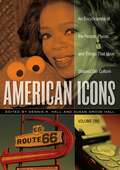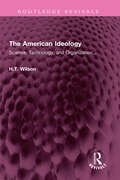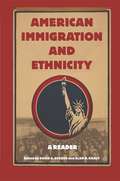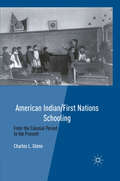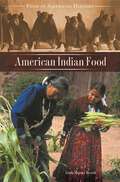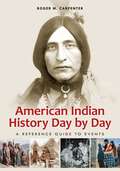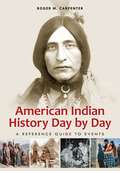- Table View
- List View
An American Icon in Puerto Rico: Barbie, Girlhood, and Colonialism at Play (Transnational Girlhoods #4)
by Emily R. Aguiló-PérezSince her creation in 1959, Barbie has become an icon of femininity to girls all over the world. In this study, author Emily R. Aguiló-Pérez focuses on a group of multigenerational Puerto Rican women and girls, exploring how playing with Barbie dolls as children has impacted their lives. By documenting the often-complicated relationships girls have with Barbie dolls, Aguiló-Pérez highlights the ways through which women and girls construct their own identities in relation to femininity, body image, race, and nationalism through Barbie play.
An American Icon in Puerto Rico: Barbie, Girlhood, and Colonialism at Play (Transnational Girlhoods #4)
by Emily R. Aguiló-PérezSince her creation in 1959, Barbie has become an icon of femininity to girls all over the world. In this study, author Emily R. Aguiló-Pérez focuses on a group of multigenerational Puerto Rican women and girls, exploring how playing with Barbie dolls as children has impacted their lives. By documenting the often-complicated relationships girls have with Barbie dolls, Aguiló-Pérez highlights the ways through which women and girls construct their own identities in relation to femininity, body image, race, and nationalism through Barbie play.
American Icons [3 volumes]: An Encyclopedia of the People, Places, and Things that Have Shaped Our Culture [3 volumes]
by Dennis Hall Susan G. HallWhat do Madonna, Ray Charles, Mount Rushmore, suburbia, the banjo, and the Ford Mustang have in common? Whether we adore, ignore, or deplore them, they all influence our culture, and color the way America is perceived by the world.In this A-to-Z collection of essays scholars explore more than one hundred people, places, and phenomena as they seek to discover what it means to be labeled icon. From the Alamo to Muhammad Ali, from John Wayne to the zipper, the American icons covered in this unique three-volume set include subjects from culture, law, art, food, religion, and science. By providing numerous ways for the reader to engage in the process of interpreting these images and artifacts, the work serves as a unique resource for students of American history and culture. Features 100 illustrations.What do Madonna, Ray Charles, Mount Rushmore, suburbia, the banjo, and the Ford Mustang have in common? Whether we adore, ignore, or deplore them, they all influence our culture, and color the way America is perceived by the world. This A-to-Z collection of essays explores more than one hundred people, places, and phenomena that have taken on iconic status in American culture. The scholars and writers whose thoughts are gathered in this unique three-volume set examine these icons through a diverse array of perspectives and fields of expertise. Ranging from the Alamo to Muhammad Ali, from John Wayne to the zipper, this selection of American icons represents essential elements of our culture, including law, art, food, religion, and science. Featuring more than 100 illustrations, this work will serve as a unique resource for students of American history and culture.The interdisciplinary scholars in this work examine what it means when something is labeled as an icon. What common features do the people, places, and things we deem to be iconic share? To begin with, an icon generates strong responses in people, it often stands for a group of values (John Wayne), it reflects forces of its time, it can be reshaped or extended by imitation, and it often breaks down barriers between various segments of American culture, such as those that exist between white and black America, or between high and low art. The essays contained in this set examine all these aspects of American icons from a variety of perspectives and through a lively range of rhetoric styles.
American Identities: An Introductory Textbook
by Judith E. Smith Lois P. Rudnick Rachel Lee RubinAmerican Identities is a dazzling array of primary documents and critical essays culled from American history, literature, memoir, and popular culture that explore major currents and trends in American history from 1945 to the present. Charts the rich multiplicity of American identities through the different lenses of race, class, and gender, and shaped by common historical social processes such as migration, families, work, and war. Includes editorial introductions for the volume and for each reading, and study questions for each selection. Enables students to engage in the history-making process while developing the skills crucial to interpreting rich and enduring cultural texts. Accompanied by an instructor's guide containing reading, viewing, and listening exercises, interview questions, bibliographies, time-lines, and sample excerpts of students' family histories for course use.
The American Ideology: Science, Technology, and Organization... (Routledge Revivals)
by H.T. WilsonFirst published in 1977 The American Ideology presents an analysis of the ways in which Americans and the most advanced capitalist countries think about science, technology, and organization. In particular, the author describes it as an anti-sociological essay set within the broader area between sociology and philosophy as functionally legitimate disciplines within the academic division of labour. The ‘American ideology’ seems to revolve around the concepts of rationality and domination; the tension between these concepts is central to the work of Hegel, Marx, Weber, and the Frankfurt School. The author argues in particular that the social sciences are unavoidably a part of the problem expressed through this tension and not a neutral means of observing and resolving it from a distance. This book is an essential read for students and scholars of sociology, political science, and political philosophy.
The American Ideology: Science, Technology, and Organization... (Routledge Revivals)
by H.T. WilsonFirst published in 1977 The American Ideology presents an analysis of the ways in which Americans and the most advanced capitalist countries think about science, technology, and organization. In particular, the author describes it as an anti-sociological essay set within the broader area between sociology and philosophy as functionally legitimate disciplines within the academic division of labour. The ‘American ideology’ seems to revolve around the concepts of rationality and domination; the tension between these concepts is central to the work of Hegel, Marx, Weber, and the Frankfurt School. The author argues in particular that the social sciences are unavoidably a part of the problem expressed through this tension and not a neutral means of observing and resolving it from a distance. This book is an essential read for students and scholars of sociology, political science, and political philosophy.
American Immigration and Ethnicity: A Reader
by D. Gerber A. KrautThis work aims to enrich studies of American immigration history by combining and comparing the experiences of both European immigration, in the nineteenth and early twentieth centuries, and Asian, Hispanic, Caribbean, and African immigrations in the late twentieth and twenty-first centuries.
American Immigration Policy: Confronting the Nation's Challenges (Public Administration, Governance and Globalization #1)
by Steven G. Koven Frank GötzkeCollaboration can be a painful process, especially between authors of different disciplines. This book is an outgrowth of discussions between a Political Scientist and Economists at the School of Urban and Public Affairs, University of Louisville. The Economics perspective is found in Chapter 3 and was largely written by Frank Götzke. The Political Science oriented review, Chapters 2 and 6,aswellasall the case studies were largely provided by Steven Koven. Most of the book, but es- cially Chapters 4, 5, and 7 evolved as a consequence of conversations between the two authors. We believe the product of two disciplinary approaches has produced a collective outcome that is greater than the sum of individual parts would have been. In this book we have attempted to combine the analytical, empirical, historical, political, and economics approaches. Chapter 3 presents an analytical model, based on economics, Chapters 4 and 5 summarize empirical census data related to im- grants, and Chapter 6 reviews the legislative and political history of immigration.
The American Imperial Gothic: Popular Culture, Empire, Violence (The Cultural Politics of Media and Popular Culture)
by Johan HoglundThe imagination of the early twenty-first century is catastrophic, with Hollywood blockbusters, novels, computer games, popular music, art and even political speeches all depicting a world consumed by vampires, zombies, meteors, aliens from outer space, disease, crazed terrorists and mad scientists. These frequently gothic descriptions of the apocalypse not only commodify fear itself; they articulate and even help produce imperialism. Building on, and often retelling, the British ’imperial gothic’ of the late nineteenth century, the American imperial gothic is obsessed with race, gender, degeneration and invasion, with the destruction of society, the collapse of modernity and the disintegration of capitalism. Drawing on a rich array of texts from a long history of the gothic, this book contends that the doom faced by the world in popular culture is related to the current global instability, renegotiation of worldwide power and the American bid for hegemony that goes back to the beginning of the Republic and which have given shape to the first decade of the millennium. From the frontier gothic of Charles Brockden Brown's Edgar Huntly to the apocalyptic torture porn of Eli Roth's Hostel, the American imperial gothic dramatises the desires and anxieties of empire. Revealing the ways in which images of destruction and social upheaval both query the violence with which the US has asserted itself locally and globally, and feed the longing for stable imperial structures, this book will be of interest to scholars and students of popular culture, cultural and media studies, literary and visual studies and sociology.
The American Imperial Gothic: Popular Culture, Empire, Violence (The Cultural Politics of Media and Popular Culture)
by Johan HoglundThe imagination of the early twenty-first century is catastrophic, with Hollywood blockbusters, novels, computer games, popular music, art and even political speeches all depicting a world consumed by vampires, zombies, meteors, aliens from outer space, disease, crazed terrorists and mad scientists. These frequently gothic descriptions of the apocalypse not only commodify fear itself; they articulate and even help produce imperialism. Building on, and often retelling, the British ’imperial gothic’ of the late nineteenth century, the American imperial gothic is obsessed with race, gender, degeneration and invasion, with the destruction of society, the collapse of modernity and the disintegration of capitalism. Drawing on a rich array of texts from a long history of the gothic, this book contends that the doom faced by the world in popular culture is related to the current global instability, renegotiation of worldwide power and the American bid for hegemony that goes back to the beginning of the Republic and which have given shape to the first decade of the millennium. From the frontier gothic of Charles Brockden Brown's Edgar Huntly to the apocalyptic torture porn of Eli Roth's Hostel, the American imperial gothic dramatises the desires and anxieties of empire. Revealing the ways in which images of destruction and social upheaval both query the violence with which the US has asserted itself locally and globally, and feed the longing for stable imperial structures, this book will be of interest to scholars and students of popular culture, cultural and media studies, literary and visual studies and sociology.
American Independent Cinema: indie, indiewood and beyond
by Geoff King Claire Molloy Yannis TzioumakisThe American independent sector has attracted much attention in recent years, an upsurge of academic work on the subject being accompanied by wider public debate. But many questions remain about how exactly independence should be defined and how its relationship might be understood with other parts of the cinematic landscape, most notably the Hollywood studios. Edited and written by leading authors in the field, American Independent Cinema: indie, indiewood and beyond offers an examination of the field through four sections that range in focus from broad definitions to close focus on particular manifestations of independence. A wide variety of examples are included but within a framework that offers insights into how these are related to one another. More specifically this collection offers: an account of recent developments as well as reviewing, reassessing and revising a number of central positions, approaches and arguments relating to various parts of the independent and/or indie sector. Individual case studies that range from the distinctive qualities of the work of established ‘quality’ filmmakers such as Wes Anderson, Steven Soderbergh and Rebecca Miller to studies of horror genre production at the more ‘disreputable’ end of the independent spectrum. Examples of the limits of independence available in some cases within Hollywood, including studies of the work of Stanley Kubrick and Hal Ashby. Case studies of under-researched areas in the margins of American independent cinema, including the Disney nature films and Christian evangelical filmmaking. A number of wider overview chapters that examine contemporary American independent cinema from a number of perspectives. Together, the chapters in the collection offer a unique contribution to the study of independent film in the United States. Contributors: Warren Buckland, Philip Drake, Mark Gallagher, Geoff King, Peter Krämer, Novotny Lawrence, James MacDowell, Claire Molloy, Michael Z. Newman, Alisa Perren, James Russell, Thomas Schatz, Michele Schreiber, Janet Staiger, Yannis Tzioumakis, Sarah Wharton
American Independent Cinema: indie, indiewood and beyond
by Geoff King Claire Molloy Yannis TzioumakisThe American independent sector has attracted much attention in recent years, an upsurge of academic work on the subject being accompanied by wider public debate. But many questions remain about how exactly independence should be defined and how its relationship might be understood with other parts of the cinematic landscape, most notably the Hollywood studios. Edited and written by leading authors in the field, American Independent Cinema: indie, indiewood and beyond offers an examination of the field through four sections that range in focus from broad definitions to close focus on particular manifestations of independence. A wide variety of examples are included but within a framework that offers insights into how these are related to one another. More specifically this collection offers: an account of recent developments as well as reviewing, reassessing and revising a number of central positions, approaches and arguments relating to various parts of the independent and/or indie sector. Individual case studies that range from the distinctive qualities of the work of established ‘quality’ filmmakers such as Wes Anderson, Steven Soderbergh and Rebecca Miller to studies of horror genre production at the more ‘disreputable’ end of the independent spectrum. Examples of the limits of independence available in some cases within Hollywood, including studies of the work of Stanley Kubrick and Hal Ashby. Case studies of under-researched areas in the margins of American independent cinema, including the Disney nature films and Christian evangelical filmmaking. A number of wider overview chapters that examine contemporary American independent cinema from a number of perspectives. Together, the chapters in the collection offer a unique contribution to the study of independent film in the United States. Contributors: Warren Buckland, Philip Drake, Mark Gallagher, Geoff King, Peter Krämer, Novotny Lawrence, James MacDowell, Claire Molloy, Michael Z. Newman, Alisa Perren, James Russell, Thomas Schatz, Michele Schreiber, Janet Staiger, Yannis Tzioumakis, Sarah Wharton
American Indian Culture [2 volumes]: From Counting Coup to Wampum [2 volumes] (Cultures of the American Mosaic)
by Bruce E. Johansen, EditorThis invaluable resource provides a comprehensive historical and demographic overview of American Indians along with more than 100 cross-referenced entries on American Indian culture, exploring everything from arts, literature, music, and dance to food, family, housing, and spirituality.American Indian Culture: From Counting Coup to Wampum is organized by cultural form (Arts; Family, Education, and Community; Food; Language and Literature; Media and Popular Culture; Music and Dance; Spirituality; and Transportation and Housing). Examples of topics covered include icons of Native culture, such as pow wows, Indian dancing, and tipi dwellings; Native art forms such as pottery, rock art, sandpainting, silverwork, tattooing, and totem poles; foods such as corn, frybread, and wild rice; and Native Americans in popular culture. The extensive introductory section, breadth of topics, accessibly written text, and range of perspectives from the many contributors make this work a must-have resource for high school and undergraduate audiences.
American Indian Culture [2 volumes]: From Counting Coup to Wampum [2 volumes] (Cultures of the American Mosaic)
by Bruce E. JohansenThis invaluable resource provides a comprehensive historical and demographic overview of American Indians along with more than 100 cross-referenced entries on American Indian culture, exploring everything from arts, literature, music, and dance to food, family, housing, and spirituality.American Indian Culture: From Counting Coup to Wampum is organized by cultural form (Arts; Family, Education, and Community; Food; Language and Literature; Media and Popular Culture; Music and Dance; Spirituality; and Transportation and Housing). Examples of topics covered include icons of Native culture, such as pow wows, Indian dancing, and tipi dwellings; Native art forms such as pottery, rock art, sandpainting, silverwork, tattooing, and totem poles; foods such as corn, frybread, and wild rice; and Native Americans in popular culture. The extensive introductory section, breadth of topics, accessibly written text, and range of perspectives from the many contributors make this work a must-have resource for high school and undergraduate audiences.
American Indian Ethnic Renewal: Red Power and the Resurgence of Identity and Culture
by Joane NagelDoes activism matter? This book answers with a clear "yes." American Indian Ethnic Renewal traces the growth of the American Indian population over the past forty years, when the number of Native Americans grew from fewer than one-half million in 1950 to nearly 2 million in 1990. This quadrupling of the American Indian population cannot be explained by rising birth rates, declining death rates, or immigration. Instead, the growth in the number of American Indians is the result of an increased willingness of Americans to identify themselves as Indians. What is driving this increased ethnic identification? In American Indian Ethnic Renewal, Joane Nagel identifies several historical forces which have converged to create an urban Indian population base, a reservation and urban Indian organizational infrastructure, and a broad cultural climate of ethnic pride and militancy. Central among these forces was federal Indian "Termination" policy which, ironically, was designed to assimilate and de-tribalize Native America. Reactions against Termination were nurtured by the Civil Rights era atmosphere of ethnic pride to become a central focus of the native rights activist movement known as "Red Power." This resurgence of American Indian ethnic pride inspired increased Indian ethnic identification, launched a renaissance in American Indian culture, language, art, and spirituality, and eventually contributed to the replacement of Termination with new federal policies affirming tribal Self- Determination. American Indian Ethnic Renewal offers a general theory of ethnic resurgence which stresses both structure and agency--the role of politics and the importance of collective and individual action--in understanding how ethnic groups revitalize and reinvent themselves. Scholars and students of American Indians, social movements and activism, and recent United States history, as well as the general reader interested in Native American life, will all find this an engaging and informative work.
American Indian/First Nations Schooling: From the Colonial Period to the Present
by C. GlennTracing the history of Native American schooling in North America, this book emphasizes factors in society at large - and sometimes within indigenous communities - which led to Native American children being separate from the white majority. Charles L. Glenn examines the evolving assumptions about race and culture as applied to schooling, the reactions of parents and tribal leadership in the United States and Canada, and the symbolic as well as practical role of indigenous languages and of efforts to maintain them.
American Indian Food (Food in American History)
by Linda Murray BerzokThis, the first, in-depth survey of Native American Indian foodways is an amazing chronicle of both human development over thousands of years and American history after the European invasion. It sheds light not only on this group and their history but on American food culture and history as well. For thousands of years an intimate relationship existed between Native Americans and their food sources. Dependence on nature for subsistence gave rise to a rich spiritual tradition with rituals and feasts marking planting and harvesting seasons. The European invasion forced a radical transformation of the indigenous food habits. Foodways were one of the first layers of culture attacked. Indians were removed from their homelands, forced to cultivate European crops such as wheat and grapes, new animals were introduced, and the bison, a major staple in the Great Plains and West, was wiped out. Today, American Indians are trying to reclaim many of their food traditions. A number of their foodways have become part of the broader American cookbook, as many dishes eaten today were derived from Native American cooking, including cornbread, clam chowder, succotash, grits, and western barbeque.The story of Native American foodways presented here is an amazing chronicle of both human development over thousands of years and American history after the European invasion. Through cultural evolution, the First Peoples worked out what was edible or could be made edible and what foods could be combined with others, developed unique processing and preparation methods, and learned how to preserve and store foods. An intimate relationship existed between them and their food sources. Dependence on nature for subsistence gave rise to a rich spiritual tradition with rituals and feasts marking planting and harvesting seasons. The foodways were characterized by abundance and variety. Wild plants, fish, meat, and cultivated crops were simply prepared and eaten fresh or smoked, dried, or preserved for lean winters. The European invasion forced a radical transformation of the indigenous food habits. Foodways were one of the first layers of culture attacked. Indians were removed from their homelands, forced to cultivate European crops, such as wheat and grapes, new animals were introduced, and the bison, a major staple in the Great Plains and West, was wiped out. Today, American Indians are trying to reclaim many of their food traditions. Other traditions have become part of the broader American cookbook, as many dishes eaten today were derived from Native American cooking, including cornbread, clam chowder, succotash, grits, and western barbeque.The scope is comprehensive, covering the six major regions, from prehistory until today. Chapters on the foodways history, foodstuffs, food preparation, preservation, and storage, food customs, food and religion, and diet and nutrition reveal the American Indians' heritage as no history can do alone. Examples from many individual tribes are used, and quotations from American Indians and white observers provide perspective. Recipes are provided as well, making this a truly indispensable source for student research and general readers.
American Indian History Day by Day: A Reference Guide to Events
by Roger M. CarpenterThis unique, day-by-day compilation of important events helps students understand and appreciate five centuries of Native American history.Encompassing more than 500 years, American Indian History Day by Day: A Reference Guide to Events is a marvelous research tool. Students will learn what occurred on a specific day, read a brief description of events, and find suggested books and websites they can turn to for more information. The guide's unique treatment and chronological arrangement make it easy for students to better understand specific events in Native American history and to trace broad themes across time.The book covers key occurrences in Native American history from 1492 to the present. It discusses native interactions with European explorers, missionaries and colonists, as well as the shifting Indian policies of the U.S. government since the nation's founding. Contemporary events, such as the opening of Indian casinos, are also covered. In addition to accessing comprehensive information about frequently researched topics in Native American history, students will benefit from discussions of lesser-known subjects and events whose causes and significance are often misunderstood.
American Indian History Day by Day: A Reference Guide to Events
by Roger M. CarpenterThis unique, day-by-day compilation of important events helps students understand and appreciate five centuries of Native American history.Encompassing more than 500 years, American Indian History Day by Day: A Reference Guide to Events is a marvelous research tool. Students will learn what occurred on a specific day, read a brief description of events, and find suggested books and websites they can turn to for more information. The guide's unique treatment and chronological arrangement make it easy for students to better understand specific events in Native American history and to trace broad themes across time.The book covers key occurrences in Native American history from 1492 to the present. It discusses native interactions with European explorers, missionaries and colonists, as well as the shifting Indian policies of the U.S. government since the nation's founding. Contemporary events, such as the opening of Indian casinos, are also covered. In addition to accessing comprehensive information about frequently researched topics in Native American history, students will benefit from discussions of lesser-known subjects and events whose causes and significance are often misunderstood.
American Indian Identity: Citizenship, Membership, and Blood (Native America: Yesterday and Today)
by Se-ah-dom Edmo jessie Young Alan ParkerThis single-volume book contends that reshaping the paradigm of American Indian identity, blood quantum, and racial distinctions can positively impact the future of the Indian community within America and America itself.This academic compendium examines the complexities associated with Indian identity in North America, including the various social, political, and legal issues impacting Indian expression in different periods; the European influence on how self-governing tribal communities define the rights of citizenship within their own communities; and the effect of Indian mascots, Thanksgiving, and other cultural appropriations taking place within American society on the Indian community. The book looks at and proposes solutions to the controversies surrounding the Indian tribal nations and their people.The authors—all leading advocates of Indian progress—argue that tribal governments and communities should reconsider the notion of what comprises Indian identity, and in doing so, they compare and contrast how indigenous people around the world define themselves and their communities. Chapters address complex questions under the discourse of Indian law, history, philosophy, education, political science, anthropology, art, psychology, and civil rights. Topics covered in depth include blood quantum, racial distinctions, First Nations, and tribal citizenship.
American Indian Identity: Citizenship, Membership, and Blood (Native America: Yesterday and Today)
by Se-ah-dom Edmo jessie Young Alan ParkerThis single-volume book contends that reshaping the paradigm of American Indian identity, blood quantum, and racial distinctions can positively impact the future of the Indian community within America and America itself.This academic compendium examines the complexities associated with Indian identity in North America, including the various social, political, and legal issues impacting Indian expression in different periods; the European influence on how self-governing tribal communities define the rights of citizenship within their own communities; and the effect of Indian mascots, Thanksgiving, and other cultural appropriations taking place within American society on the Indian community. The book looks at and proposes solutions to the controversies surrounding the Indian tribal nations and their people.The authors—all leading advocates of Indian progress—argue that tribal governments and communities should reconsider the notion of what comprises Indian identity, and in doing so, they compare and contrast how indigenous people around the world define themselves and their communities. Chapters address complex questions under the discourse of Indian law, history, philosophy, education, political science, anthropology, art, psychology, and civil rights. Topics covered in depth include blood quantum, racial distinctions, First Nations, and tribal citizenship.
The American Indian in Western Legal Thought: The Discourses of Conquest
by Robert A. WilliamsExploring the history of contemporary legal thought on the rights and status of the West's colonized indigenous tribal peoples, Williams here traces the development of the themes that justified and impelled Spanish, English, and American conquests of the New World.
The American Indian Mind in a Linear World: American Indian Studies and Traditional Knowledge
by Donald FixicoFirst published in 2003. Routledge is an imprint of Taylor & Francis, an informa company.
The American Indian Mind in a Linear World: American Indian Studies and Traditional Knowledge
by Donald FixicoFirst published in 2003. Routledge is an imprint of Taylor & Francis, an informa company.
The American Indian Oral History Manual: Making Many Voices Heard
by Barbara W Sommer Mary Kay Quinlan Charles E TrimbleOral history is a widespread and well-developed research method in many fields—but the conduct of oral histories of and by American Indian peoples has unique issues and concerns that are too rarely addressed. This essential guide begins by differentiating between the practice of oral history and the ancient oral traditions of Indian cultures, detailing ethical and legal parameters, and addressing the different motivations for and uses of oral histories in tribal, community, and academic settings. Within that crucial context, the authors provide a practical, step-by-step guide to project planning, equipment and budgets, and the conduct and processing of interviews, followed by a set of examples from a variety of successful projects, key forms ready for duplication, and the Oral History Association Evaluation Guidelines. This manual is the go-to text for everyone involved with oral history related to American Indians.

